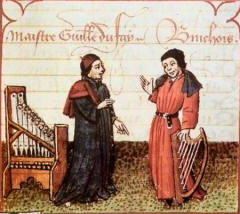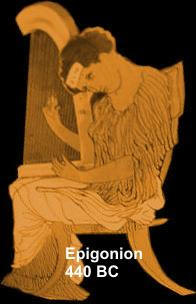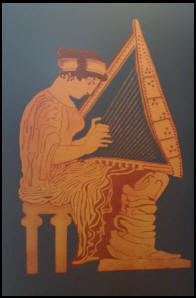La Storia
LA STORIA - La tradizione narra che il primo esemplare aveva solo quattro corde e fu costruito da Epigonio, uno dei più celebri musici dell’antichità, vissuto qualche decennio prima di Omero. L'Epigoneion è datato circa 430 a.C, ed è un antico strumento a corde, qualcosa di simile ad una moderna arpa o un salterio suonato in Grecia in epoca classica.
 La sua
forma ci è stata tramandata da diverse scoperte archeologiche (per lo
più opere di pittura) e passi letterari in cui poeti e scrittori
dell’antichità descrivono questo singolare oggetto. Benchè l'antico epigoneion sia presto
andato in disuso, forse a causa del suono troppo debole e a volte
instabile, può essere considerato uno dei progenitori di strumenti a
corde moderni come l'arpa, il clavicembalo, il salterio.
La sua
forma ci è stata tramandata da diverse scoperte archeologiche (per lo
più opere di pittura) e passi letterari in cui poeti e scrittori
dell’antichità descrivono questo singolare oggetto. Benchè l'antico epigoneion sia presto
andato in disuso, forse a causa del suono troppo debole e a volte
instabile, può essere considerato uno dei progenitori di strumenti a
corde moderni come l'arpa, il clavicembalo, il salterio.
A distanza di 2500 anni un gruppo di ricercatori italiani, che lavorano al progetto internazionale inserito nel VII Programma Quadro dell'UE ASTRA (Ancient Instruments Sound/Timbre Reconstruction Application, sono riusciti a riprodurre virtualmente, grazie all’aiuto di un potente software, le note e i suoni dell’epigoneion, uno degli strumenti musicali più celebri nell’antica Grecia.
EPIGONION - From Wikipedia, the free encyclopedia
An epigonion was an ancient
stringed instrument mentioned in
Athenaeus (183 A.D.), probably a
psaltery. The epigonion was invented, or at least introduced
into
Greece by
Epigonus of Ambracia, a Greek musician of
Ambracia in
Epirus, who was admitted to citizenship at
Sicyon as a recognition of his great musical ability and of
his having been the first to pluck the strings with his fingers,
instead of using the
plectrum. The instrument, which Epigonus named after
himself, had forty strings.
It was undoubtedly a kind of harp or psaltery, since in an instrument of so many strings some must have been of different lengths, for tension and thickness only could hardly have produced forty different sounds, or even twenty, supposing that they were arranged in pairs of unisons. Strings of varying lengths require a frame like that of the harp, or of the Egyptian cithara which had one of the arms supporting the cross bar or zugon shorter than the other, or else strings stretched over harp-shaped bridges on a sound-board in the case of a psaltery.
Juba II, king of Mauretania, who reigned from 30 BC, said (Ap. Athen. l.c.) that Epigonus brought the instrument from Alexandria and played upon it with the fingers of both hands, not only using it as an accompaniment to the voice, but introducing chromatic passages, and a chorus of other stringed instruments, probably citharas, to accompany the voice. Epigonus was also a skilled citharist and played with his bare hands without plectrum. Unfortunately we have no record of when Epigonus lived. Vincenzo Galilei has given us a description of the epigonion accompanied by an illustration, representing his conception of the ancient instrument, an upright psaltery with the outline of the clavicytherium (but no keyboard).


